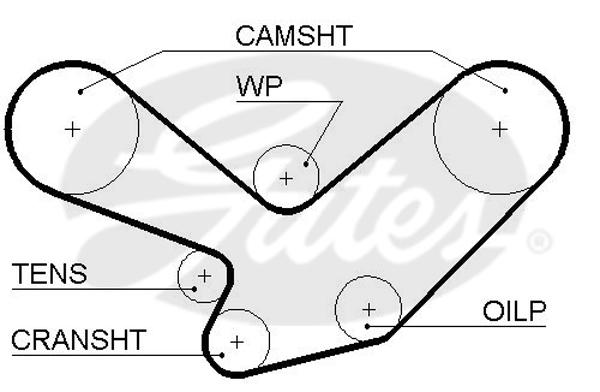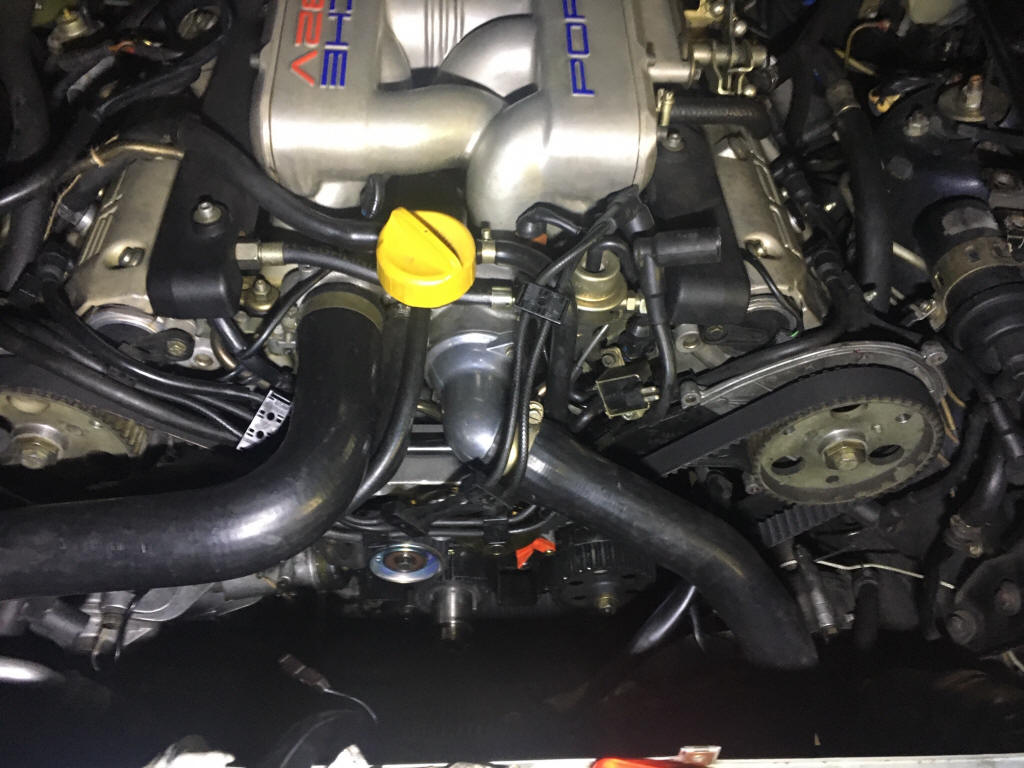


First tip: print the procedure from John's excellent website:
http://members.rennlist.com/pirtle/tbelt.html
=============
Here's a Timing belt replacement tip passed onto me by Pete Loedding.
Before taking the tension off the old belt, set it to the TDC position as
detailed in the Service Manuals. (Make sure all the marks line up as they
should.) Then, turn the crank to the 45 degree mark. Make a paint
mark on
each of the cam-shaft gears directly across the reference marks. Rotate
the crank again to 45 degree to verify that the new marks line up with the
reference points. If so, place the engine lock in place and remove and
reinstall the belt at the 45 degree mark.
The reason for doing it this way is to avoid any movement of the cams,
since there is no additional spring load on any of the valves while at the
45 degree position. YMMV.
~ Merry motoring ~
Ed Ruiz
=============
Dear fellow sharksters:
After washing the GT, I decided to check the T-belt
tension with the J. Kemp re-make of the original
tensioner tool.
Unlike the pre-S models, the GT does have a bit more
to remove in order to gain access to check the T-belt.
The first thing I did was remove the fan shroud with
its two electric fans. Once that was out of the way,
it was easy to get to nearly everything at the front
of the engine. I then removed the right side
distributor and then the two bolts that hold the right
side T-belt access cover in place. I turned the
engine over by the crank pully bolt (clockwise) to
O/T.
The belt tension was just within specs, so I added a bit more. After each check and retensioning, I
rotated the crank two full rotations back to O/T.
Once the tension was just a bit over half-way in the
window, I set the lock bolt, then buttoned it all back
up. Total time for the job was about an hour.
Merry motoring, ~ Ed ~
=============
>What is the purpose of rotating the cams 45 degree before locking the
crank and installing the belt? I am doing this procedure this weekend if all prevails.
The 45 deg position (on the crank, not the cams) is the only position where
you can be assured that there will be no valve-to-piston contact when you
rotate the cams independently. This is the position for taking the cams off
and putting them back, or for changing the timing belt.
Wally Plumley
=============
Hi Johnny,
>My belt is broken and my favorite car just got four cylinders running!! How do I change the belt, rotors direction etc...??
Workshop Manual, Volume 1A, Section 28 , Pages 48, 48a, 48b... or you can
call me for verbal instructions, it is not hard at all.
>Rotor number one is ok of course but what will be the position of the other
one.
> It is possible to check this out by controlling the pistons but I want to
know if there is an >easier way for instance rotor two related the rotor
one or something like that
Remove the 2 distributor caps, while facing the engine look down at the 2
"circles" where the caps mount, the rear (primary) will have a notch
on the
perimeter at approx. 4 o'clock, the front (secondary) will have a notch at
approx. the 10 o'clock position. Rotate the engine (27mm socket via crank
bolt) clockwise till the primary rotor lines up with the 4 o'clock notch.
When you replace the belt, position the secondary rotor to the 10 o'clock
position.
David Roberts
928 SPECIALISTS
===============================
Hi all,
I am in the middle of replacing the timing belt on my 87 S4 and I just
realized that I made a mistake. When I marked my cam sprockets at 45
degrees, I didn't rotate the crankshaft past TDC before stopping at the 45
degree mark. In other words, I was at TDC and I rotated the crankshaft
clockwise to 45 degrees. What has occurred is that now that I have the belt
off, the left (drivers side) camshaft has rotated approximately one tooth
away from where I made the erroneous 45 degree mark, it doesn't appear to
turn easily by hand.
Can I just rotate the camshaft back to where it should be relative to the
other camshaft and crankshaft? Do I have to rotate it just the one tooth
width or do I have to do almost one complete revolution?
Thanks
Jamie Howton
============
Hi Jamie,
The direction you turn the cams or crank should only matter when you have the
belt on. With the belt on if you go CCW you will overload the tensioner.
I think you are fine with what you did. The valve springs will tend to pull
the cams one way or another when the belt is taken off. I wouldn't move the
crank at this point as you would probably hit a valve or three while doing it.
Put the crank at 45 deg. from the closest direction. put the belt on the tensioner,
past the crank and oil pump, up over the left side cam. Line it up on your mark
while doing it. past the water pump to the right cam, lining it up as you put
the belt on. (you will probably need a wrench on the cam to move it easily,
those springs are tough. snug up the tensioner and look at all your marks. If
they look good walk the crank around by hand and check on the second rev of
the crank where the marks are. if they are all where they belong (the factory
TDC ones) then tension the belt properly and you should be set.
I always am nervous in situations like this and do at least a triple check
of everything before lighting the fire though.
Grasser
=========================
Ryan,
You are in fine shape here. There is no big thing on a 16 valve engine
setting the belt. You do not need to worry about bending the valves
because
this is a non interference engine. If it wasn't setting the crank to TDC
and locking and then turning the cams would be bad and you would encounter
resistance in turning them as the valves opened and contacted the pistons.
On a four cycle engine - at least everyone I have seen the crank makes two
revolutions for every revolution of the cam. It is no different on a
Porsche - although I hear they are working on changing that.
So take off the distributor cap and find TDC with the rotor pointing to
cylinder 1. Put the distributor cap back on so you do not damage
anything..
Next set the cams to the timing mark. - You should only turn the cams in
the clockwise direction or you take a chance of loosening the cam drive nut.
The cams will spring back because they are now loaded. So the best bet is
to get the cams just before TDC so that they are not yet spring loaded.
Take the timing belt and feed it around the crank and oil pump. The teeth
on the crank will lock the belt in place. It is easier with a second
person
to keep a little tension on the back side of the belt in the initial stages
so it does not slip on the crank.
Work the belt up over the left cam. Just before you set the belt to the
left cam crank the cam up to the timing mark. Lock the cam gear in place
with the belt but putting forward tension on. This will set the first cam
in time with the crank.
Keep working the belt forward over to the right cam. When you get there
also crank the right cam to the timing mark and loop the belt over it. At
that point the belt is more or less in place. Put some tension on the belt
with the tensioner. It helps if you mark the place on the tensioner
adjustment of where it was when you started the job because that will be a
very close to the correct tension. I use the lock nut to mark this point.
Crank the engine over by hand - I remove the spark plugs just to make it
easier. As you come up on TDC check to see if both cam marks line up.
They
may not and if so you will have to back the belt off and set them up. It
is
not necessary to remove the belt and start over at that point as you can
just loosen the tension and work the belt backwards. You will probably
find
that due to slack in the belt on the first pass that you are off a tooth on
one gear or the other. It is easier if this is the right cam gear - but no
matter just back it off and reset it. The second time it will be easier as
the belt will now have been stretched out a little and the previous slack
will not throw you off.
Once the marks line up I turn the engine over 5 or ten times by hand to seat
the belt and then use the tool to set the tension. Turn the engine over 10
times more by hand and check the tension. The tension on a 16 valve engine
should be 4.5 on the gauge.
I have a page posted of things not to do that may help you.
http://www.kondratyev.com/porsche/belt_-78-84.htm
Dan B,
=============
VERY important. Many people make that mistake. The engine MUST be at TDC when measuring timing belt tension (0|T marker). Any other point will show the wrong value and your belt will probably be too loose. Also, never turn the engine back if you overshoot TDC, not even 1mm. If you do, the tension value you get will be wron